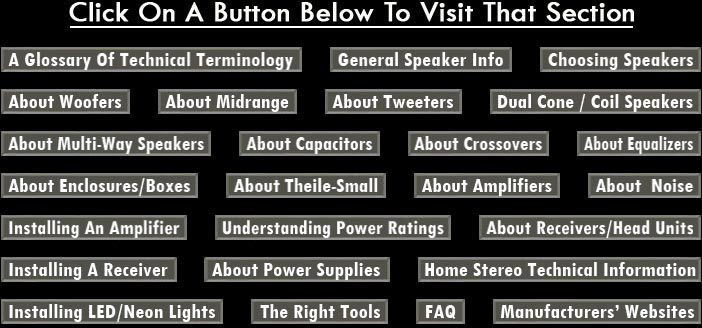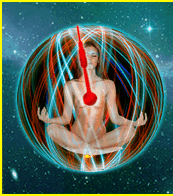


Cabin Gain
A low frequency boost normally obtained inside a vehicle interior when woofers are optimally in phase, and with the proper enclosures.
Canon/Cannon
Brand name of multipoint connector used for professional audio equipment. Also known as XLR connectors.
Capacitance
The property of an electric device that permits the storage of energy as a result of electric displacement when opposite surfaces of conductive plates are maintained at a difference of potential. In a capacitor, capacitance is the measure of the property (the amount of charge that can be stored) equal to the ratio of the charge on either surface to the potential difference between the surfaces. Capacitance is measured in Farads, and micro, or pico-farads for smaller units..
Capacitor (Power audio)
Power stabilizing capacitors store the necessary power amplifiers need to punch larger bass notes while limiting clipping. They store energy during intervals when it is not required, which is most of the time, and release it when demand exceeds what is available from the car's power system. The amount of capacitance to be used is half (.5) farad per 500 watts of available RMS power. Capacitors are not used with amplifiers that supply less than 300 watts RMS in total.
Cardioid
"Heart" shaped pickup pattern characteristic of some microphones which reduces sensitivity to sounds from the sides and back.
CD Compact Disc
The most popular format for conveying music and data currently available. It is among the first digital media to take over from the analog formats of phonograph records and tapes; coming to the market in the early 1980's. Developed by Phillips, Sony, and Pioneer, it records information on the now familiar shiny discs by deforming the inner metal foil on the disc with tiny micro pits burned in by a laser. These pits taken together, form a binary digital code, which when converted to bits, then bytes, can recreate the original information, such as audio. It's superiority as a format, consists of the fact that the process gets around such problems as: noise, hiss, pops, transducer irregularities, and other audible problems that made analog carriers a less than fully high fidelity mode. Dynamic range exceeds 100 decibels, a sufficient soft/loud difference to make the reproduction very lifelike. Frequency response is at the theoretical limits of human hearing and unwanted aural artifacts are generally below the threshold of perception. The only significant improvement is the DVD borne addition of multiple channels, to recreate the original sonic environment. In short, it's the best thing to come along since Mozart sat down at the piano.
CD Controller
This is a device that can exist either incorporated into a car stereo receiver (head unit) or as a separate module. In either case in contains the operating controls necessary to use a CD player or changer. This will usually include but is not limited to such favorites as: play, stop, FF, REW, pause, Track, and disk. As with a good many other things, most controllers and the units they control are incompatible with any model other than the one they were made for. There are the occasional rare exceptions, but yours is not likely to be one of them.
CD Head Unit
Is usually a single disc player installed as a separate unit (not including a radio receiver). These are increasingly uncommon.
CD Receiver
Multiple function receivers are most commonly configured with radio and CD player capabilities in standard car receiver (head end) units. These may include cassette tape decks as well, and may also have high power amplifiers (over 15 watts RMS) installed in them. Some units may even have mini 3 to 5 disc changers in them. Among common and desirable features are:
Four speaker outputs with a fader control to balance front and back; Bass and Treble controls; Left right balance; 12 or more presets for AM & FM stations; Random play for the CD; digital clock. FM mono sensitivity should be at least 13dBf. Preamp outputs are desirable: minimum output voltage should be at least 1.8 volts. Also, audio line inputs for the CD changer you may want later. Remember that RMS output power is usually no more than half of the "peak power" rating.
CD Changer
Separate units that may allow the user to hear any of 3 to 120 discs, or more in whatever order they wish to program them, or to skip from one track to another, or from one disc to another. Many of these come with separate controller units that allow for user operation and programming. Some are built to take advantage of controller systems built in to many receivers expressly for that model. Many also have a device called an FM modulator that permits connection to any standard FM stereo radio. The signal can be heard on whatever unused frequency the radio is tuned to. Most changers also permit direct audio outputs to any standard RCA high impedance, line level, input. This is the preferred input to avoid noise and distortion that may occur with radio usage.
Center Channel
in home theater, a signal sent to a speaker mounted in front of the listener, specially designed to enhance voices and sound effects associated with center stage action from a movie soundtrack. Sometimes used in car audio to help offset skewed stereo imaging due to seating positions in the automotive environment.
Channel
Common name for a complete amplifying stage in any audio amplifier. Most amplifiers are denominated as 1, 2, 4, 5, or 6 channel units. Each of these is a discrete audio amp on its own, capable of taking a small line signal input and amplifying it sufficiently to be heard on an appropriate speaker. Some amplifiers are capable of bridging two channels together, to form one channel of double the power of each separately. The manufacturer's instructions differ widely on how to accomplish this, and each must be followed exactly.
Chebyshev Filter
A filter that has some ripple in the pass-band but has an initial attenuation slope which is steeper than a Butterworth filter.
Chord
A combination of two or more notes played simultaneously
Circuit Breaker
An electrical switch that automatically breaks a circuit if the current through it is higher than its rating. Once tripped it can be manually reset. Performs the same function as a fuse, but eliminates the need for replacement after activating.
Clipping
A signal that results from an amplifier that is either overloaded or underpowered relative to the signal Amplitude it being asked to generate. A clipped waveform is one in which the gently rounded peaks and valleys of the AC audio wave are instead sliced off or clipped, to yield what looks a lot like a square or alternating DC wave. When DC is applied to a speaker, the voice coil has no means of propelling itself relative to a constant magnetic field. Instead, it can only convert the incoming current to heat, and ultimately burns up. The effect of alternating DC on speakers is remarkable, irritating, painful, and short. If you are able to hear evident Distortion at high volume levels, or smell smoke, reduce the volume. It may already be too late for your speakers, but at least you may be able to save the amplifier.
CMS
referring to the compliance of the mechanical suspension of a speaker cone, consisting of the spider and surround.
Coaxial Cable
A single copper conductor, surrounded with a layer of insulation, covered by a surrounding copper shield and finally, an insulating jacket. A constant-impedance unbalanced transmission line. In audio, this type is commonly used for low level, line signals terminated in RCA connectors.
Coloration
A term used to describe levels of audio Distortion that cause serious departures from a true High Fidelity rendition of the original signal.
Compliance
The measurement in liters or cubic feet of the volume of air that is equal to the compliance, or maximum extension of a speaker's total suspension.
Component System
This term is used in relation to speaker systems, to indicate a system in which separate mounting arrangements are provided for each component of the system. In a typical car system you might see a woofer in a box in the rear, midranges at the side and tweeters mounted on the dash panel. This compares to the typical integrated speaker enclosure in which all the Drivers are mounted in the same box.
Compression (Audio)
The process of reducing the dynamic range of a given analog audio program by making the loud parts quieter and the quiet parts louder
Compression (Data
The process of packing digital data, such as computer files, more efficiently for the purpose of storage or transmission. Commonly referred to as 'stuffing' or 'zipping' a file.
Compression (Audio/Video Files
A process of temporarily or permanently reducing audio data for more efficient storage or transmission. A temporary reduction in file size is called 'non-lossy' compression, and no information is lost. A permanent reduction in file size (such as with mp3 files) is called 'lossy' compression, and involves discarding (supposedly) unnecessary information which is irretrievably lost.
Compression Driver
Compression drivers are usually dynamic; that is, with a magnet and interacting coil arrangement, and a small diaphragm as the main transducer. These are the motor parts, also known as the driver, of a compression horn tweeter or compression horn general-purpose speaker, such as those used for Public Address (PA) purposes. These drivers are usually coupled to the throat of an exponential horn. Such an arrangement enables this type of tweeter to have very high directional characteristics, which allows them to be especially effective in situations requiring a very wide sound field. In typical home and car stereo near-field applications, large horns can be a bit too narrowly directional to be practical. For this reason, compression horn systems are usually found only in special purpose speakers used in mid and wide field applications such as PA systems or the sound systems installed in large theaters. However, some specialized horns have small apertures and very shallow horns, and can be quite suitable for close spaces.
Compressor
A type of dynamic range processor which reduces the gain of audio signals which are over an adjustable 'threshold' level, therefore reducing the dynamic range. Generally allows the operator control over threshold, ratio, attack and release times. Both analogue and digital types are available.
Comb Filter Effect
This acoustical and electronic effect occurs when two signals interact in such a way as to produce an irregular spiked and choppy response pattern. When graphed on paper, this pattern looks like the teeth of a comb, hence the name. This effect is frequently the product of overlapping outputs from the various drivers in the system. It can develop in either a single speaker between the individual drivers, or between unmatched sets of speakers. This same effect can also be produced by wall reflections and other room anomalies. The usual remedy for this, if it becomes objectionable, (not every instance is even perceived as such) is to make sure the Crossover set points are appropriate for the drivers being used, or that the crossover is operating correctly. Obviously, one should also use only compatible speaker sets.
Compression
1. An increase in density and pressure in a medium, such as air, caused intermittently by the passage of a sound wave. 2. The region in either air or material in which this occurs.
Compression Wave
A wave propagated by means of the compression of a fluid, such as a sound wave in air. To create sound, the opposite state of rarification alternates with the crest of every compression.
Constant Directivity (CD) Horn
A horn-loaded high frequency driver that exhibits more or less constant distribution of high-frequency sound in the horizontal direction. This is done by using one of several special dual shaped horn designs created to solve the traditional problem of horn-loaded driver output varying with frequency. All CD horns exhibit a high frequency roll-off of approximately 6 dB/octave beginning somewhere in the 2 kHz to 4 kHz area.
Concert Pitch
A standard for the tuning of musical instruments, internationally agreed in 1960, in which the note A above middle C has a frequency of 440 Hz.
Cone
The cone-shaped diaphragm of a speaker. This is directly attached to the voice coil motor which actions produces the pulsation's of air that the ear detects as sound. Also useful for holding ice cream.
Condenser Microphone
A mike that depends on an external power supply or internal battery to electrostatically charge capacitor plates, one of which is subjected to sonic motion. Also called a 'Capacitor' microphone.
Conductor
Materials along which electrons will flow, making them suitable for use as connecting links in electrical circuits. Also, persons who guide symphony orchestras or streetcars.
Coulomb
An amount of electrical charge which contains 6.24 x 1018 of electrons. So there!
Counter Firing
A method for reducing harmonic distortion at low frequencies that involves the use of a secondary coil in a woofer or mid bass driver to cancel non-fundamental wave elements not found in the original signal. The signal from the coil is used by the amplifier to refine it's damping control over the cone motion. This proprietary servo-feedback technology was originally developed by Velodyne in the early '90s.
Crossover
A device or passive circuit used in systems with separate tweeter and/or midrange Drivers. It Rolls Off frequencies above and below certain points in the range, to allow the sound to be tailored for the specific driver to which it is sent. Most speakers have crossovers that consist of passive elements such as capacitors, coils, and resistors to separate the various frequencies. In a bi-amped or multi-amped system, the crossover is an active device that feeds the various frequency bands to the inputs of the amplifiers that operate the individual drivers.
Crossover Frequencies
The frequencies at which a passive or electronic crossover network divides the audio signals, which are then routed to the appropriate amplifiers or speakers.
Crossover Network
A unit which divides the audio spectrum into two or more frequency bands (Also see Crossover Frequencies).
Crossover Slope
The rate at which a crossover circuit attenuates the blocked frequencies. Slope is expressed as decibels per octave. A 6dB per octave crossover reduces signal amplitude level by 6dB in every octave starting at the crossover point. This means that every time the frequency of the audio signal is changed by a factor of 2 (one octave), the level of the audio signal is attenuated by 6dB. For example, if a low-pass crossover is set at 60Hz with a 6dB slope, you'll see a drop in level of 6dB at 120Hz. With slopes of 12dB and higher, the output beyond the crossover point will be reduced to below the level of audibility.
Cross Talk
1. Undesired capacitive, inductive, or conductive coupling from one circuit, part of a circuit, or channel, to another. 2. Any phenomenon by which a signal transmitted on one circuit or channel of a transmission system creates an undesired effect in another circuit or channel. Note: In telecommunications, cross talk is usually distinguishable as speech or signaling tones.
Current
The volume or quantum of the flow of electrons through a conductor, as opposed to voltage, which is the measure of the intensity or velocity of the electrical flow.
Custom File
A feature package that provides intuitive and safe source management for an audio and A/V system. Examples include Disc Memo, Selection, Station Memo, and Memo List.
Cutoff Frequency Filters
The frequency at which a signal falls off by 3 dB (the half power point) from it's maximum value. Also referred to as the -3 dB points, or the corner frequencies
Cycles per second
See "Hertz"















